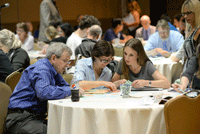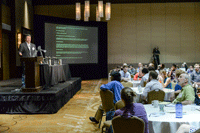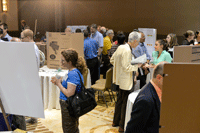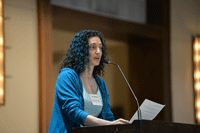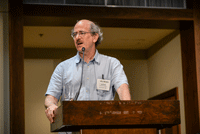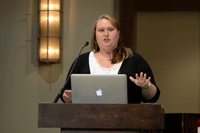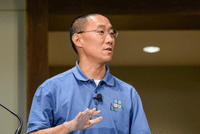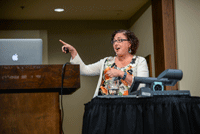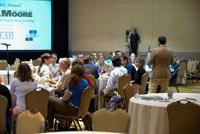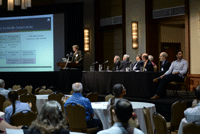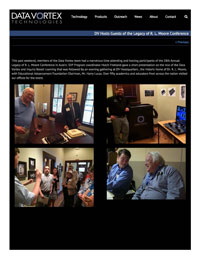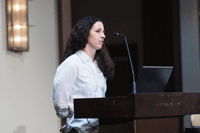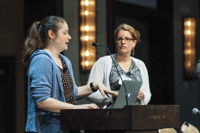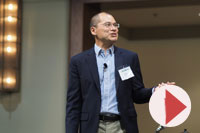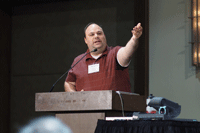Pre-Conference Workshop
9:00AM–11:30AM Classroom 103
Inquiry-Based Learning in Mathematics
Leader: Michael Starbird, University of Texas at Austin
Welcome and Overview
1:00PM–1:10PM Salon C
Theron “TJ” Hitchman, University of Northern Iowa
Victor Piercey, Ferris State University
Plenary Presentation
Inquiry-Based Learning, Mathematics Teacher Education Partnership, Fundamental Theorem of Calculus, and Me
Angie Hodge, University of Nebraska Omaha, Eric Stade and David Webb, University of Colorado Boulder
What does mathematics teacher preparation have to do with active learning in calculus? How can we affect course transformation by thinking globally and acting locally (or vice versa)? What the heck is a TACTivity, anyway, and is there an acronym for that? (FTC= Fundamental Theorem of Calculus; MTEP=Mathematics Teacher Education Partnership; IBL=well, you know.)
Parallel Sessions 1
My Favorite IBL Activity
2:30PM Exploring Frieze Patterns
Alessandra Pantano, University of California, Irvine
A frieze is a pattern that repeats in one direction. The strip pattern may exhibit additional symmetry beyond translations, namely rotations, reflections or glide reflections. These rigid motions can be combined to create a group; surprisingly, only 7 distinct group structures can arise. In this talk, we present several hands-on activities aimed at understanding and classifying frieze patterns, with an increasing level of sophistication. Students begin with simple activities designed to acquire familiarity with symmetries, such as a matching game, where different objects are matched based on their symmetries (e.g., borders of buildings, carpets, fences, sweater patterns, white and blue Ming porcelains and indigenous art). Soon after, the students are asked to produce their own frieze patterns using paper cutouts or stamps and ink. A series of questions are posed, to guide the students’ investigation of the group structure. For instance, students are asked to create a frieze pattern with prescribed symmetries and think of what additional symmetries they are forced to include. To conclude, students explore the classification of frieze patterns, and are asked to produce a decision tree to identity the symmetry group of a frieze.
3:00PM Building Numbers
Judith Covington, Louisiana State University, Shreveport
In this session I will share how to use snap cubes to help students understand prime numbers. While this activity would be best for middle school students learning about primes, I have found that this activity helps my future elementary teachers to better understand prime numbers and how they are used to create the composite numbers. I will also give some alternatives if you do not have the funds for snap cubes.
Teaching Inquiry and Promoting Questioning
2:30PM Norms and Practices in an IBL Classroom
Brian Katz, Augustana College
In an IBL course, the rituals of a lecture course are replaced with other patterns of engagement that make fundamentally different assumptions about the students’ relationship to the mathematics. In this session, we will discuss some of these patterns, called norms and classroom mathematical practices, in an effort to help us understand how they empower students to become local authorities and to take the lead in the inquiry into and proof of mathematical claims.
3:00PM Using the Moore Method to Empower Pre-Service Elementary Teachers to Write Mathematical Proofs
Jeffrey Pair, Middle Tennessee State University
I decided to teach mathematical proof to a group of pre-service elementary school teachers enrolled in a mathematics content course. Given the reputation of the Moore Method for empowering students to solve challenging problems and learn mathematical proof, I decided to use a modification of the method in my course. The goal was for students to find themselves capable of solving challenging problems. To this end I incorporated many aspects of Moore’s Method. Although collaboration with classmates was not discouraged, students were expected to solve and present proofs to the class individually. They were not allowed to consult any external resources. I designed some IBL course notes in which elementary number concepts were treated formally. After we completed the first problem set, I decided to allow the students to create definitions and generate the problem sets.
In this talk, audience members will find themselves in the shoes of the pre-service elementary teachers who took the course. Participants will create definitions, brainstorm and conjecture, prove theorems, and learn how similar activities were approached by pre-service elementary teachers in a mathematics content course taught using the Moore Method.
Flipped Course Environment and IBL
2:30PM Flipping the Calculus 1 Course: Influence on Student Achievement and Attitudes
Milan Sherman, Drake University
The popularity of using flipped models of instruction in services courses in undergraduate mathematics is growing, as evidenced by the number of presentations on this topic at this conference. This model provides a means for transforming lecture-based courses into inquiry-based courses, and instructors generally report increased student engagement. However, there is still a dearth of evidence on how these course influence students, both in terms of achievement and attitudes. In this presentation I report on a study of flipped vs. traditional models of instructions in two sections of Calculus I offered in the Fall of 2014. The Calculus Concepts Inventory (CCI) was used to measure student achievement pre/post. All classes were videotaped, and the Reformed Teaching Observation Protocol (RTOP) was used to measure the degree to which instruction was “reformed” i.e., inquiry-based. In addition, focus group interviews were conducted with all students in both sections. While the RTOP demonstrates quantitatively that the two forms of instruction were very different, the survey data demonstrate little difference in the achievement and attitudes between the two groups. Potential reasons for these results are discussed in terms of implications for flipping undergraduate mathematics courses.
3:00PM Three Keys for IBL Style Flipping
Amanda Matson, Clarke University
This talk will focus on three keys to a flipped classroom with an IBL atmosphere: getting the students ready to learn; showing students how to learn; and, empowering students to be the decision makers. To get the students ready to learn, they read articles about growth-mindsets and submitted motivational phrases to me that they thought might help them when they got stuck later in the semester. In this talk, I will provide links to the articles, sample motivational phrases, and how I incorporated them in my class. To show them how to learn, I provided them with a recipe for doing homework. What comes naturally to me is foreign to some of the students. Having a recipe to follow (and adapt to personal preferences) gives students a place to start. In this talk, I will provide a link to the recipe I gave the students and welcome discussion on what works for you when you approach a topic you do not know. To empower students to be decision makers, I incorporated a number of pedagogies I have picked up from the 2013 IBL Workshop and the 2014 Legacy of R. L. Moore and IBL Conference. In this talk, I will provide examples of these with special focus on the power of little slips of colored paper.
IBL: Innovation
2:30PM R.L. Moore’s Geometry – Summer 1968
Gary Richter, Southwestern University
Notes taken in summer 1968 offer a time-machine look at R. L. Moore in action. Particular attention will be paid to features of Moore’s teaching that may be overlooked in adapting Moore’s method to present-day classrooms. The student experience in Moore’s classroom will be examined for its appeal.
3:00PM What Does Education Research Have to Say About Student Outcomes of IBL in Undergraduate Mathematics?
Sandra Laursen, University of Colorado, Boulder
Mathematics serves as students’ gateway to majors and careers in STEM fields (science, technology, engineering, mathematics), but lack of success in their initial college math courses deters many STEM-intending students from progressing in their desired pathways. While studies across the STEM disciplines support the use of student-centered teaching and learning to increase student learning and persistence, there has been less previous research on these approaches in college mathematics. Our group’s study of inquiry-based learning (IBL) as implemented in over 100 course sections at four universities shows that student-centered approaches can succeed when implemented on a departmental scale (http://www.colorado.edu/eer/research/steminquiry.html ). Despite variation in how IBL was implemented, student outcomes are improved in IBL courses relative to traditionally taught courses, as assessed by general measures that apply across course types. Particularly striking, the use of IBL eliminates a sizable gender gap that disfavors women students in lecture-based courses. Other evidence suggests particular benefits to initially lower-achieving students. The study supports the application of IBL as a means to improve learning outcomes and, ultimately, student retention in college mathematics. In this session, I will not present new findings, but rather will highlight key results from past work that members new to the IBL mathematics community may find useful to consider and to share with students and colleagues.
Break for Refreshments
3:30PM–4:00PM Room 301
Parallel Sessions 2
My Favorite IBL Activity
4:00PM Self-Assessment of Failure and Success
Edgar Parker, Retired, James Madison University
Day-to-day assessment fuels the dynamics of an IBL course, but end-of-course self-assessment may also be a part of carrying forward the efficacy of IBL courses. Experience in mentoring has shown me that practitioners, particularly new practitioners, tend to be hypercritical in evaluating themselves. In this talk, I offer examples, mostly from my own teaching, where perceived successes and perceived failures are closely related in hopes of suggesting that practitioners look hard for both success and lack of success in what they have done.
4:30PM I’m An Actuary!
Anders Hendrickson, St. Norbert College
As students' intuitive meaning of "probability" is notoriously vague, there are many well-known activities, such as repeatedly rolling dice or drawing M&M's from bags, to help students grasp the notion of empirical probability. Such activities often have three drawbacks, however: they can take up a large amount of class time, they foster a belief that probability is mostly about games of chance, and they may suggest that empirical probability is merely a stepping-stone to theoretical calculations. We describe and demonstrate an IBL approach that addresses all three of these concerns through an actuarial activity played on mobile applications.
Student Voices on the IBL Experience
4:00PM Stories of Empowerment: The IBL Experience for Non-Math Majors in an Upper Division Math Course
Danielle Champney, Cal-Poly State University, San Luis Obispo
One of the biggest barriers for non-math majors, upon entering an upper division mathematics course, is linguistic. Learning the language of mathematics is a vital tool if one hopes to participate in mathematical discussions, make conjectures, and pursue their ideas toward personal mathematical discoveries, but in the traditional manner, we have found that some of these linguistic barriers make it hard for non-math majors to find entry points into the study of subjects in which they are wholly competent and very insightful. One way that these non-math majors have felt empowered in upper division math courses is through the use of IBL, and inquiry techniques that have the ability to normalize the level of language while keeping the mathematical engagement high, so that everyone has an entry point into a deep and meaningful discussion about the material. Several non-math majors will share their stories, and describe ways in which they have felt empowered and found great success in upper division math classes through the use of IBL techniques. These stories also connect to broader themes in productive disciplinary engagement, linguistics, authority, and equity, and through hearing from the perspective of some non-math majors, we hope to share some of the ways that IBL may be used to engage a broader audience in deep mathematical conversations that they would otherwise find it difficult to enter.
4:20PM Hands-On, Minds-On Calculus: Student Style
John Buckley, Riley Hester, Angie Hodge, Izzy Tollefsrud, and Katie Wanek, University of Nebraska Omaha
As students who have taken a calculus course taught using inquiry-based learning, we have a unique perspective on IBL Calculus. We know first-hand the rewards of being in an active learning environment and we also understand the challenges that many students face in an IBL classroom. In this presentation, we will share our perspectives on inquiry-based learning and how it has influenced our attitude towards math and even our future career choices. We will also lead the audience through some of our favorite IBL Calculus activities! Note: No prior calculus knowledge is required to attend!
4:40PM Student Panel Discussion
Flipped Course Environment and IBL
4:00PM Flipped Infrastructures for Inquiry-Based Learning
Robert Talbert, Grand Valley State University
Flipped course environments provide a fertile ground for inquiry-based learning in at least two ways. First, by giving students first exposure to basic content prior to class time, time and space are freed up so that the entire class meeting can be focused on core IBL activities. Second, by having students take control of learning activities to prepare for class, student can develop self-regulated learning skills and attitudes that are important to successful problem-solving and lifelong learning. The flipped classroom is an "operating system" on which the IBL "app" can run very effectively. Ideally, student in an IBL course will arrive at class time having made first contact with essential course material and fluent in the basic terminology and mathematical objects needed to work on more complex problems; and by preparing for class in this way, the IBL student will incrementally improve his or her levels of independence and self-efficacy. But at least three different design elements in a flipped environment can either help or hinder these goals. First, the "intellectual ecosystem" in which students operate—the text and video resources they can access, the asynchronous and synchronous help they can receive, and so on—must truly support independent learning. Second, the activities students do to prepare for class, in which they first contact essential course content and prepare themselves for more complex work, must be structured and accessible. Third, formative assessment data must flow freely from student to instructor and back to the student in the form of feedback, both before and during class. In this session, participants will discuss all three of these design elements—the course ecosystem, pre-class activities, and formative assessment—in the context of effective IBL course design and implementation. Short case studies and exemplars will be presented, and participants will brainstorm questions and ideas for working with their own IBL courses using a flipped structure.
4:30PM Classroom Setting Using the Flipped and Inquiry-Based Learning Approach
Padraig McLoughlin and Perry Lee, Kutztown University of Pennsylvania
For the past four semesters (including the present Spring 2015 semester), one author implemented a method which uses both the Flipped (or inverted) and the Inquiry-Based Learning (IBL) methods (or the F/IBL method) into his large College Algebra classrooms for managing and engaging students both inside and outside the classroom setting. For Spring 2014; Fall 2014; and, Spring 2015 semesters, student-learned outcomes were assessed to determine the effectiveness of this F/IBL approach in the large College Algebra classroom compared to multi-sections other large College Algebra classrooms that were taught using the traditional lecture-style methods. In these large multi-section classrooms, student scores were collected by prescribing two assessments during each semester: pre-assessment and the post-assessment scores using Educational Testing Services (ETS) standardized Elementary Algebra Skills Assessments (EAS). The presentation will highlight the latest findings of how this F/IBL method is implemented and managed into a large classroom. Additionally, a summary of assessment data based on student learned outcomes from those multi-sections of College Algebra classrooms that participated in the assessment study is presented. Then a synopsis of what the findings indicate to date; ramifications of the finding; and, where, what, and how the research shall be focused shall be discussed.
Teaching Inquiry and Promoting Questioning
4:00PM Looking at Examination Papers to Help Students Learn to Prove in an IBL Transition-to-Proof Course
Ahmed Benkhalti, John and Annie Selden, New Mexico State University
We present the results of an analysis of undergraduate students’ examination papers from an IBL transition-to-proof course. Students’ papers were considered from the point of view of their actions (mental, as well as physical), instead of their possible misconceptions. In doing so, we identified process, rather than mathematical content, difficulties, and this has resulted in the detection of both beneficial actions and detrimental actions that students often take. Thus far, we have identified the following categories of difficulties: omitting beneficial actions; taking detrimental actions; inadequate proof framework (e.g., not unpacking the conclusion); mathematical syntax errors; wrong or improperly used definitions; misuse of logic; insufficient warrant; assumption of all or part of the conclusion; extraneous statements; assumption of the negation of a previously established fact; difficulties with proof by contradiction; inappropriately mimicking a prior proof; mathematical syntax errors, failure to use cases when appropriate; incorrect deduction; assertion of an untrue result; and computational errors. Examples of some of these difficulties will be presented. We will also suggest some teaching interventions that might alleviate some of these difficulties. For example, a good place to start might be with proof frameworks, as a number of difficulties seem to be traceable to not writing part or all of a proof framework. A proof framework is determined by the logical structure of what is to be proved. One writes the hypotheses at the top, leaves a blanks space, and writes the conclusion at the bottom. Often one can obtain a “second level” framework by “unpacking” the conclusion to determine what to write just after the hypotheses and just before the conclusion. We have found that some students tend to resist writing full proof frameworks. We think this is because it involves writing in a way that is not “from the top down”. To accomplish this teaching early, and in a reasonable amount of time, it is probably better to begin by asking students to practice constructing only proof frameworks, not entire proofs. Hands on activities will include writing proof frameworks and analyzing some student proof attempts for beneficial and detrimental actions.
4:30PM The Credit Earning Opportunity as the Means for Course Grades: A Natural Fit for IBL
Robert Peacock, Young Harris College
I have implemented a scheme for calculating course grades that is flexible enough to apply to just about any (or even all?) mathematics course and, more interestingly, fits naturally with the IBL concept. I call it the ``credit earning opportunity'' method. Based directly on a thorough itemization of expected skills represented in the course, I determine a table-formatted schedule that specifies a student's course grade as a function only of ``credits'' earned in the course. As I put to the students in the syllabus, a ``credit'' is earned from a presented question by answering the question correctly, showing complete and correct work. A “credit earning opportunity'' is a battery of questions, presented to students in a class meeting, allowing students to earn credit(s) in the course. ``Credit earning opportunities'' are presented it throughout the semester. I will present what I believe are advantages or positive features of the ``credit earning opportunity'' method. There should be an ample percentage of the allotted presentation time period for questions and further discussion.
Dinner
The Southwestern Experience: An Institutional Commitment to Engaged Student Learning
Edward Burger, Southwestern University
Here we will offer some examples of inquiry-based learning, engaged and student-led learning, and flipped-classroom experiments that are revolutionizing how Southwestern University, as an institution, defines education as a truly life-changing experience in which students strive for deep understanding, effective and creative thinking, and moving knowledge forward.
Friday, June 26
Posters
- Naneh Apkarian
- John Boller
- Jane Cushman
- Mark Daniels & Michael Starbird
- Justin Dunmyre
- Shawn Firouzian
- Megan Heenehan
- Bill Jacob
- Brendan Kelly
- Ted Mahavier
- Ted Mahavier & David Clark
- Milos Savic
- Therese Shelton
- Ralf Spatzier
- Nina White
- Daniel Visscher
- Stan Yoshinobu
5–Minute Reports I
Roundtable Discussions
11:00 AM –12:00 AM Salon C
Organizer: Brian Katz
Lunch
Empowering Students through Contiguous Learning
David Clark, SUNY New Paltz
This talk will present a new IBL course sequence in real analysis that is specifically designed to empower future teachers by giving them a depth of understanding that underlies the material they will teach. Through the example of real analysis, we will see how IBL can more generally empower students to learn beyond the course and how the modern formulation of geometry fails to empower. We will then see how an alternate version of geometry can dovetail with the new real analysis to revitalize the high school mathematics curriculum. Those interested in pilot testing the new real analysis notes are invited to discuss them with the author and pick up a copy from the display room.
5–Minute Reports II
Parallel Sessions 3
My Favorite IBL Activity
2:00PM Team-Solving Problems in IBL Classes
Xiao Xiao, Utica College
Student presentations and discussions take up the majority of the class time in my upper level classes such as introduction to proof, abstract algebra and linear algebra. It is not uncommon to have a problem that no one in the class is ready to present at a given day but the class really needs to solve that problem to move forward. So what should the instructor do to initiate a discussion? While the traditional Moore method demands that students should not collaborate, the modified Moore method that I employ encourages student collaborations especially in the classroom. In this talk, I will discuss various strategies that I have adopted to guide students to team-solve problems through some of my classroom videos. I will show you some of my students’ mathematical work submitted before the class and we will see how they handled the challenges during the class. Participants will be divided into groups to share thoughts on whether they think the strategies were successful or not, and maybe propose alternative solutions to the not so successful ones.
2:30PM Co-constructing a Group Proof
Sarah Bleiler and Jeffrey Pair, Middle Tennessee State University
In this interactive session, participants will engage in the group proof activity. This activity has been a regular component of an IBL transition-to-proofs course. To implement this activity, students in the IBL course create proofs individually for problems in their problem set (Taylor, 2007) and submit those electronically to the instructor before the subsequent class. During the subsequent class, small groups of three to four students work together to share their individual arguments, consider the strengths and areas for improvement of each argument, and combine their individual ideas to create a group proof that best communicates their ideas to the rest of the class. After creating their group proof, students present their arguments to the whole class and seek feedback from their peers. In working together to construct a group argument, students often find themselves negotiating the criteria for what should count as a valid mathematical proof, receiving constructive feedback that leads to the identification of mathematical errors, and acquiring new ideas and techniques to be used during future proof construction. During this session, participants will engage in co-constructing a group proof. Each participant will receive a sample student argument for the proposition, “An integer n is even if and only if $$n^2$$ is even.” Then, participants will use these samples to build a proof that takes into consideration the strengths and areas for improvement of all the individual arguments. Reference: Taylor, R. (2007) “Introduction to proof,” Journal of Inquiry-Based Learning in Mathematics, 4, 1-37.
3:00PM When Students Provide the Definitions
Alfonso Gracia-Saz, University of Toronto
How do we empower students to come up with their own definitions? In a traditional Moore method course we give students full definitions and statements of theorems, and we ask them to produce proofs. I am fond of a modified format, where I ask students to solve a problem that will lead them to come up by themselves with the definition of the next concept I was planning to introduce. This creates invested students who care about the precision of their definitions. In this session, I will share some examples from my classes, and then I will invite the audience to create other such definition-inducing problems. To be productive, I want to focus the session only on math courses for math students at the college level (such as calculus, analysis, algebra, topology, or combinatorics).
Teaching Inquiry and Promoting Questioning
2:00PM Mock Intro to Proofs Course
Susan Crook, Loras College
2:30PM Stop and Go Activity: What Can We Do When Our Students Get Stuck?
Stan Yoshinobu, Cal Poly State University, San Luis Obispo
This session is an activity-based session focused on a specific IBL teaching skill, handling situations when students make mistakes. We will study 3 short video clips, where students make mistakes or get stuck. We will then STOP the clip, and participants will discuss IBL teaching options to handle the specific situation. Then we'll GO to the next clip. This session is intended for experienced IBL instructors, although all interested conference participants are encouraged to attend.
3:00PM Using Mathematical Question Stems to Teach Questioning in Mathematics: An Example from Abstract Algebra
Suzanne Dorée, Augsburg College
A touchstone for inquiry-based teaching is a quote written by author Alice Wellington Rollins in the Journal of Education in 1898 which I paraphrase here in gender-neutral form as -- The test of a good teacher is not how many questions the teacher can ask that pupils will answer readily, but how many questions the teacher inspires her pupils to ask which the teacher finds hard to answer. But how do we teach our students to ask questions? Numerous authors, including Walter Bateman in the classic Open to Question: The Art of Teaching and Learning by Inquiry and Stephen Brown (later with Marion Walter) in The Art of Problem Posing have proposed using “question stems” (a.k.a. question starters) to help students develop this important learning skill. Recent texts such as Dan Rothstein and Luz Santana’s Make Just One Change: Teach Students to Ask Their Own Questions continue this call. In this how-to session, participants will test their own question-posing skills on a question I’ve used in my Abstract Algebra course. Then we’ll extend our question list by using a few of classic mathematical question stems. To illustrate the power of such easily generated questions, I’ll describe some of my students’ results and further questions. I’ll close with information on resources for additional question-teaching strategies.
Flipped Course Environment and IBL
2:00PM Engaging Students in a Flipped College Algebra Class
Violeta Vasilevska, Utah Valley University
In the last few years I have been teaching a hybrid College Algebra class. The structure of the class is as follows: students are asked to view the video lectures on line and solve the homework before they come to class. In class (that meets 3 times per week) the instructor does not lecture, rather just answers questions from students. This semester I have been trying different ways to “force students” to come to class prepared and to engage them in class as much as possible. For example, the video lectures are a requirement to access the homework; the homework is due half an hour before class, etc. In class, in response to student questions I ask them questions back so that they actually answer their own questions. After all questions are answered students are given a quiz (most of the time a group quiz). They apply the knowledge and practice the new concepts, discuss the questions, and learn from each other. I will demonstrate how the Q/A part of the class is conducted, and share some survey results about the structure of this course.
2:30PM Fostering Students’ Preparation and Achievement in Upper Level Math Courses
Ali Shaqlaih and Mehmet Celik, North Texas at Dallas
We will present a Hybrid Inquiry Based Learning strategy that we used in our classes to motivate students to prepare for upper-level mathematics classes. The strategy increased motivation for class preparation which, in turn, fostered students’ in- and out-of-class interactions and boosted “students’” self-confidence on studying math on their own. The efficiency of the strategy, the assessment methods and students’ achievement will be presented.
3:00PM Teaching Questioning through Flipping in College Algebra
Jacqueline Jensen-Vallin, Lamar University
This session begins with audience members reading an excerpt from a college algebra textbook and taking a reading quiz. The information gained from this interaction will then guide our conversation in a mock (and shortened) flipped classroom experience. This technique was used with much success both at Slippery Rock University in Pennsylvania (for general students) and at Lamar University in Texas (for STEM students). The session will end with us discussing the benefits and drawbacks of this effective technique.
IBL Innovations
2:00PM When IBL is not Enough
Gary Richter, Southwestern University
Paul Halmos famously said: "The Moore Method is the right way to teach anything and everything." For those who find this position extreme, the IBL community offers a wealth of alternative methods. But are these enough? This talk examines the (heretical?) possibility that the answer is "no." Are there students who simply are neither ready nor sufficiently prepared to benefit from IBL instruction? Rather than supply an answer, this talk will explore the tension between the latter view and the Halmos quote.
2:30PM Abstract Algebra—IBL Style—Year 3
Mary Shepherd, Northwest Missouri State University
My first year of teaching Abstract Algebra was a bad experience, both for me and the students. A year ago, in my second year of teaching Abstract Algebra, partly due to a change in the book, the experience was generally good, for both me and the students, but there was still room for improvement. This past semester, the third time for teaching the class, has students engaged, presenting, critiquing other student proofs and some of the students will continue and take a second semester of Abstract Algebra. This talk will discuss the changes made, the lessons learned in 3 years of teaching this course, and give you a flavor of the types of activities that engage the students.
3:00PM The Fundamental Theorem of Calculus
Paul Foerster, Alamo Heights High School
On the first day of my Advanced Placement Calculus BC course (equivalent to Calculus 1 and 2), students learn that calculus involves just four concepts: limits, derivatives, integrals, and integrals. Thus the stage is set for inquiry into the meanings of these concepts, and why two of them share the same name. This presentation shows how students inquire into the last phrase in the preceding sentence after having learned that derivatives are limits of average rates of change, definite integrals are limits of Riemann sums, and indefinite integrals are antiderivatives. Students discover a way to apply the mean value theorem to an antiderivative to select the sample points in a Riemann sum in such a way that the sum is independent of the number of increments. They then are led to squeeze this constant Riemann sum between the limits of lower and upper sums, thus discovering that definite and indefinite integrals share the same name because the latter can be used to evaluate the former. Bring your TI-83 or TI-84 calculator for a hands-on inquiry into the methods used!
Break for Refreshments
3:30PM–4:00PM Room 301
Structured Discussion Time
4:00PM–4:45PM
Salon AB
Flipped Learning Environment, Robert Talbert, Grand Valley State University
Salon C
New Users, Nissa Yestness, University of Northern Colorado
Salon DE
Math Teacher Circles, Angie Hodge, University of Nebraska Omaha and Judith Covington, Louisiana State University, Shreveport
Classroom 203
SIGMAA on IBL, Victor Piercey, Ferris State University
What We Have Learned about IBL at the Centers?
4:45 PM –5:30 PM Salon C
Moderator: William “Bill” Hamilton
Panelists: John Boller, University of Chicago; Ron Douglas, Texas A&M University; Bill Jacob, University of California, Santa Barbara; Sandra Laursen, University of Colorado at Boulder; Ralf Spatzier, University of Michigan; Michael Starbird, University of Texas at Austin
An Invitation
6:00PM–7:00 PM
During your free evening you are invited to visit the open house at RL Moore’s former home at 2303 Rio Grande. Light refreshments will be served.
Thanks to its association with Professor Moore during his 50-year career at Texas, the home is a City of Austin Landmark and has a Texas State Marker. It is currently the headquarters of Data Vortex Technologies, founded by Coke Reed, a student of Moore and H. S. Wall.
There is a permanent exhibit relating to Dr. Moore and information will be available on the Data Vortex Student Inquiry and Innovation Program. A Data Vortex computer with the latest Intel chips will also be demonstrated.
The house is within easy walking distance of the AT&T center and maps are available at the registration desk.
Saturday, June 27
Parallel Sessions 4
My Favorite IBL Activity
9:00AM IBL Structure of Math Course, Challenges and Achievements
Krishna Kaphle, University of Maine at Fort Kent
University of Maine is a rural university and majority students are under prepared for college level math courses. Structure of Math is a course designed for students in the Elementary Education major. We found using IBL method for such a group of students to be challenging. We would like to share my experience on using IBL method in this course for a group of students with a poor prior math background.
9:30AM Systematically Implementing IBL in a Number and Operations Course for Preservice K-6 Teachers
Tom Judson, Stephen F. Austin State University
A growing body of evidence shows that inquiry-based learning can lead to student success in learning mathematics. However, an IBL course for preservice EC–6 teachers may look very different than an IBL graduate topology course. The work of Liping Ma (Knowing and Teaching Elementary Mathematics, 1999) focused on the deep mathematical understanding needed to successfully teach elementary school mathematics, and The Mathematical Education of Teachers II (Conference Board on the Mathematical Sciences, 2012) recommends that courses for prospective teachers should develop such an understanding. To meet these demands we have implemented an activity-based course for EC–6 preservice teachers. We will not only describe a typical lesson but also how we have implemented this course in all sections for all students.
10:00AM Vector Calculus Techniques My Students Have Taught Me
Amy Ksir, United States Naval Academy
When teaching calculus for the Nth time, it can feel as though we know all of the tricks. Doing the work to create an IBL environment gives us the opportunity to step back and watch our students find these, and new tricks, for themselves. This semester in Calculus III, my students have invented (so far!) two completely new (to me), legitimate, and easy ways of solving some standard problems in multivariable calculus. I will present their results and describe the context in which they were developed.
Teaching Inquiry and Promoting Questioning
9:00AM The Challenges of Teaching Developmental Mathematics Courses
Carolyn Luna, The University of Texas at San Antonio
Current curriculum standards for developmental mathematics courses require educators to cover chapters of content ranging from solving rational equations to dividing by complex numbers. Students, who often still struggle with using the addition principle to solve linear equations, suffer with this push for breadth of content over a deeper understanding of the course topics. Educators who teach these classes, however, have many tools at their disposal to enliven their classrooms and make mathematics appealing to struggling students. By actively engaging students in lessons that encourage mathematical discourse and peer interaction, developmental mathematics courses can stimulate higher order thinking that is motivated by the learners themselves. Although the breadth of the course content may be sacrificed for a deeper understanding of more fundamental mathematical topics, students will actually enjoy learning by doing a subject most of them once dreaded.
9:30AM Modeling and Inquiry in Undergraduate Differential Equations
Karen Bliss and Jessica Libertini, Virginia Military Institute
Differential equations, as a field of mathematics, evolved in many ways to meet the needs of scientists and engineers trying to answer questions in their own fields. Differential equations courses, however, often focus on the mathematical structure of and techniques for solving differential equations, which can be presented devoid of applications, or with only a nod to over-idealized applications after one has learned a solution technique. Using a modeling-forward approach invites inquiry, motivates students, and provides students opportunities to practice using skills that employers in business/industry want. Participants will be invited to experience what a modeling-first activity might look like in the classroom through the presentation of several examples, which might include the collection of data or using data from a journal in another discipline. In such a class, students might be invited to answer a question (such as predicting a future outcome or finding the optimal way of doing something), or they can be invited to ask their own questions about a scenario, e.g., “Will this quantity continue to decrease over time? What’s the end behavior?” Students are not handed a differential equation model; they must think about what a sensible model might be by asking questions and making observations. Once a differential equation model is developed, students are motivated to find a solution so they can answer these and their own questions. Students taking such a course develop skills employers want, such as the ability to integrate knowledge across disciplines. They build problem-solving skills and maintain a big-picture perspective as they develop solutions. A modeling-first approach also lends itself nicely to group projects, fostering students’ oral communication skills and ability to navigate group dynamics. Further, students practice written communication of their work, and the instructor can tailor the assignments so that the students are writing with a particular audience (stakeholder) in mind. Participants will be introduced to a community called SIMIODE (Systemic Initiative for Modeling Investigations and Opportunities with Differential Equations, www. simiode.org) where there is a repository of lesson materials with teacher comments and detailed pedagogical narrative, as well as collaborative opportunities for collegial instructive constructions, all freely available for instructors to use in their own classrooms.
10:00AM Integrating Technology Into An Inquiry-Based Learning Mathematics Classroom
Cindy York, Northern Illinois University and Angie Hodge, University of Nebraska Omaha
Using technology and integrating technology are two different things. To better engage learners in inquiry-based learning (IBL) we try to foster a classroom environment that integrates technology versus simply using technology. In this session, we will discuss the difference between the two and how instructors can integrate technology into their IBL mathematics classroom by putting it into the students’ hands. Many of these technology tools can be found online for free and help foster communication and collaboration among students as well as critical thinking and problem solving. Students need to be able to communicate their thinking to others and collaborate with each other, as well as experts, to help them problem solve. When the students can easily communicate with others, reliance on the instructor lessens. We will discuss and demonstrate some easy ways to integrate free technology tools into your IBL classroom.
Flipped Course Environment and IBL
9:00AM The Upstate New York IBL Consortium
Jane Cushman, Buffalo State College
In 2010, when Inquiry-Based Learning was rarely seen in Upstate New York, a few enterprising faculty members attended an MAA Prep workshop. Now, the Upstate New York IBL Consortium (UNY IBL) encompasses seventeen institutions and several dozen faculty members across the Greater New York region. We will discuss our strategies for growing IBL locally and for finding funds to support our consortium activities, in addition to the wealth of regional activities we have organized. Participants in this interactive session will develop plans to spread the use of IBL in their regions.
9:30AM IBL Instructor Training and Support Materials
sarah-marie belcastro, MathILy
Every summer undergraduate and graduate students practice teaching at intensive programs for high-school students. Those individuals need training and support if they are to be successful with IBL. To that end, the presenter has created a set of materials to help instructors figure out particular aspects of "doing" IBL. But they could be better, and the focus of this session will be attendees discussing how to improve, change, augment, or create additional materials. We will begin with a very brief overview of the training process for the summer programs MathILy and MathILy-Er—what readings are sent ahead, what activities instructors do during training meetings, and how intra-program followup and support happen. Then the four instructor guides (how to write a problem list, how to create a lesson plan, how to plan a short course, how to translate to standard college contexts) will be distributed. Attendees will be broken into groups by interest (see below for a list) and asked to discuss and critique the guides, and any other aspects of IBL instructor training that arise during their discussions. Of course, the small groups will then share their insights with the attendees as a whole! After revisions are made from attendee feedback, the new guides will be made available to those who desire them, and suggestions for appropriate dissemination will be welcomed. Questions attendees will attempt to address: (1) How can these materials be made more useful for instructors totally new to IBL? What is missing, unclear, mis-emphasized? (2) How can these materials be made more useful for instructors with prior experience of IBL as students? What is missing, unclear, mis-emphasized? (3) How can these materials be made more useful for instructors with prior experience using IBL for instruction? What is missing, unclear, mis-emphasized? (4) How can these materials be made more useful for other contexts (i.e. not summer programs)? What changes might be made?
10:00AM Inquiry-Based Homework: Writing Assignments That Are Worth Reading and Keeping
Aleksei Beltukov, University of the Pacific
While there seems to be broad agreement about the importance of writing in mathematical education, there is no consensus on how writing should be distributed throughout the curriculum, or how it should be taught and assessed. I will describe my own efforts aimed at incorporating writing into Pacific's applied mathematics program; these efforts are currently supported by the University's ``Writing in the Disciplines'' initiative. In particular, I will tell you how I avoid the ``student paper'' syndrome, the seemingly inevitable grading overload, and why many of my students keep their homework long after they graduate.
IBL Innovations
9:00AM IBL Perspectives on Assessment in the High School Classroom
Paul Secker, Northfield Mount Hermon
I would like to discuss some different aspects of IBL assessments in the high school classroom. Assessments function as vital forms of communication in IBL, as in most educational methodologies. For me, IBL’s goals can be distilled to teach two basic functions—thinking and communicating. Two years ago at the RL Moore Conference, Jim Cornette said, essentially, “The Texas method teaches people to think, and that’s been known to be useful in a number of different subjects.” I think it is this reduction that is so empowering because this reduction also expands. Its direct simplicity embraces different ways of thinking, learning and teaching. It accepts and encourages different personalities, and to a certain extent, different methodologies. The simple nature of these goals provides student and teacher greater opportunities to bring their particular strengths to bear on creating or responding to different assessments. This proposed session consists of three sections, with 10 minutes being allocated to the first two sections, and 10 minutes for the third, participatory, section. In the first section I will focus on different ways assessments have been used by some of the original practitioners of the Texas Method to communicate to their students. To provide a historical and personal context for my work, I will relate anecdotes provided by my father about assessment and grading by professors Moore and Wall. These anecdotes are vital in showing how two early practitioners of the Texas Method (each with fairly different dispositions and styles) used assessments to communicate different information in very different ways. In the second section I will describe briefly some of the assessment methods I have used to bring IBL to my own high school classroom. In what I consider a more traditional IBL assessment mode, I will discuss a problem that I use to get a sense of my students’ mathematical processes, problem solving skills, communication skills and general attitudes. With a less traditional tool, I will also look at self-assessments that I use to test and develop my students’ sense of what their work should be and get a sense of where they see themselves mathematically. Finally, in the third section, I will facilitate a discussion in which the attendees may share assessments they use and their experiences using assessments in an IBL classroom. I have become increasingly convinced that IBL is not just for graduate level college math but applies across the spectrum of mathematical experience. Instead of being a method that profits only the best of the best, I see it as a means of liberating the majority of my students who feel marginalized by more traditional, “memorize and recall the algorithm” methodologies that apply to relatively specific ways of thinking. Assessment continues to be one of the more challenging and intriguing aspects of teaching IBL at the high school level. My hope is that this session will provide some help in this effort by looking at how, in philosophy and practice, IBL encourages a creative, broad spectrum of assessment tools and purposes.
9:30AM IBL and Mathematical Puzzlehunt Competitions
Steven Clontz, Auburn University and PJ Couch, Lamar University
Traditional mathematics competitions are a great way for advanced mathematics students to show off their talents, but are not effective in promoting mathematics or IBL toward students whose imagination isn't intrinsically sparked by written mathematical puzzles. To address this need, Braxton Carrigan (SCSU) and Steven Clontz created the first mathematical puzzlehunt at Auburn University in 2012. Mathematical puzzlehunts are team-based mathematical puzzle-solving competitions which attempt to recreate the fun and educational experience of a collaborative IBL classroom within a puzzlehunt format similar to the MIT Mystery Hunt or Microsoft Puzzle Hunt. Lamar University successfully adopted a similar format in April 2015, which will expand into a national Mathematical Puzzle Programs (MaPP) competition which will launch in 2016.
10:00AM An IBL Calculus II Problem from Einstein’s Special Theory of Relativity-Generating High Interest in Mathematics and IBL
Travis A. Moebes, Sigcom Sciences, LLC
In the Special Theory of Relativity Albert Einstein expresses the energy of an object in terms of its mass and velocity q, called the MQ Equation. The MQ Equation is used to derive E = mc². E can be developed and expanded in powers of q using Taylor’s Theorem applied to the MQ Equation. Einstein gives the expansion but not the details of how the expansion is obtained. This expansion is given to the student as a problem to work out on their own. The goal was to find a good problem that lets the student obtain a feeling of success and accomplishment. One of the terms of the expansion is Kinetic Energy. About 90% of the students tested so far have accomplished the task. Several problems spinning off this problem are also given to the students.
Break for Refreshments
10:30AM–11:00AM Room 301
5–Minute Reports III
Plenary Presentation
Empowering Who? The Challenge of Diversifying the Mathematical Community
David Kung, St. Mary’s College of Maryland
Women and under-represented minorities are more likely to fall out of the STEM pipeline at every stage from middle school on. Why do we as a community of mathematics teachers in higher education need to address this issue? What can we do in our classrooms, departments, and institutions to ensure that everyone has an opportunity to succeed? Research suggests that interactive teaching methods, including IBL, might help us successfully address issues of diversity. Why do they work? What else must we do to make the mathematics world more equitable?
Concluding Remarks
12:30PM–12:45PM Theron “TJ” Hitchman, University of Northern Iowa, and Victor Piercey, Ferris State University
![[to the Legacy of R. L. Moore Home Page]](../../images/rlmlittle.jpg)



